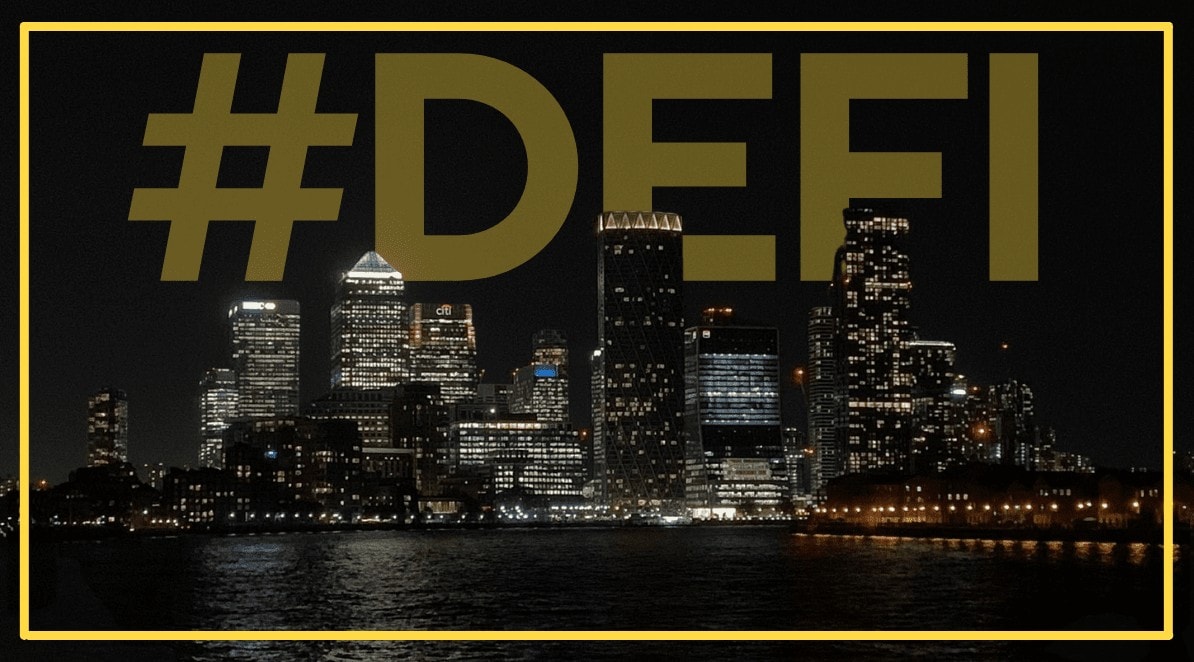While inflation fears threaten to spark volatility in financial markets across the world, investors are seeking alternative opportunities to hedge themselves against this risk. As the money locked in decentralised finance continues to skyrocket, it has started to appear on the radar of institutional investors.
IMF warns of need to be ‘very, very vigilant’ of rising inflation risks https://t.co/LuGkPji3kt
— Financial Times (@FT) October 12, 2021
Konstantin Anissimov, Executive Director at CEX.IO, shared his thoughts with us on why and how institutional investors have become more involved in decentralised finance. Starting out as a retail exchange, CEX.IO expanded into an international ecosystem of cryptocurrency products with over four million customers worldwide.
An engineer at heart, Konstantin was introduced to blockchain, and the engineering behind it, when completing his MBA course at the University of Cambridge. He quickly came to see the potential of this technology and sought to find a place for himself in the industry. He used to develop embedded software, and previously held CTO positions at several companies before arriving at CEX.IO in 2020.
As Executive Directors at CEX.IO, he is also directly engaged with CEX.IO Prime, a suite of products developed specifically to provide various digital asset services to institutional and corporate clients.
Tapping in the growth of DeFi
The DeFi space took several years to shape, with the efforts truly coming to fruition in the last year. The latest data from DeFi Pulse, a site that compiles DeFi-related data, shows that Total Value Locked in DeFi now exceeds $100 billion. To put this figure into some perspective, this number was $677 million on January 1, 2020.
Bitcoin’s record rally helped push the value of assets used in decentralized finance to $100 billion for the first time, according to data compiled by DeFi Pulse https://t.co/2pzMXHQT45
— Bloomberg (@business) October 21, 2021
“This astonishing growth points to the fact that the underlying technology behind DeFi has improved considerably,” Konstantin thinks. “In turn, institutional investors gradually came to recognise it as such. And their influence has pushed the industry towards greater maturity.”
“On top of that, institutional and retail investors alike have been looking for new solutions to protect their wealth from inflation, especially in light of the pandemic. This was part of the reason why crypto and DeFi came under greater consideration from them. High net worth individuals, corporates, and institutions are getting progressively more interested in this sector, as they want to invest major sums for longer terms.”
About a third of large institutional investors own digital assets such as Bitcoin https://t.co/18dOEandA0
— Bloomberg (@business) June 9, 2020
Institutional investors who want to tap in the growth of DeFi, however, face some unique issues that they have to overcome. The technological complexity of DeFi, for example, often deters investors from entering the field. CEX.IO, Konstantin explains, was a pioneer in eliminating these barriers and tailoring DeFi products to suit the needs of institutional clients:
“What is important for professional investors? Insurance, risk management, governance, cybersecurity. Things that can put them at ease and guarantee safety for their investments.
“Reviewing the code, smart contracts, and conducting external audits are practically a must-have for DeFi projects these days. Communities themselves promote better standards for reporting, clear roadmaps and overviews of current activities.
“Doing all of this helps projects convince potential investors that they are investing into something real, not a façade. That by entrusting their assets to a project they won’t be opening themselves up to threats like hacks and foul plays, and so on.”
Another deterring factor for institutional investors is that compliance prohibits them from participating in the ecosystem as “typical users.” That is to say, anonymously and in a truly decentralised fashion.
“To tackle these issues,” Konstantin explains, “protocols themselves, and investors, have had to improvise. Protocols have created “KYC’d” versions of their products, while DeFi “service providers” have launched services to connect these investors to the ecosystem.”
There are three main “baskets” of DeFi products that investors can allocate capital to. These, according to Konstantin, are lending/borrowing, liquidity providing, and staking.
“Staking is where institutional investors are active because they are interested in yield. Many PoS [Proof of Stake] protocols offer compounding 2% to 4% at minimum. Staking also ties into the long-term/low maintenance vision, as opposed to lending/borrowing and liquidity, which requires constant maintenance and high time preference.”
JPMorgan Says Ethereum Upgrades Could Jumpstart $40 Billion Staking Industry https://t.co/YXDu8q0zxz pic.twitter.com/dsmBeD2quA
— Forbes (@Forbes) July 2, 2021
“Staking makes it easier to stay compliant with the rules that regulate institutions relative to the other DeFi yield-bearing options. Service providers like Bison Trails and Figment have built staking products that allow these investors to easily hold and earn yield on their investments, while staying legally compliant.
“In addition, the yield earned acts as a built-in risk mitigator. Compounding growth in token balance allows volatile fiat value offset to be attractive for institutions.”
Other projects that institutional investors are particularly interested in are concerned with the scalability and interoperability of blockchain: “projects such as Polkadot (DOT) and Solana (SOL) have had a lot of attention from VCs and hedge funds.”
Shaping regulation together
Despite all the recent developments and stronger involvement from institutional investors, there still remains a considerable degree of general scepticism. The crypto space is still a relatively recent phenomenon, and the regulations surrounding it are not fully developed yet.
“Regulatory risk is a major reason why many investors are hesitant to go all in on, or increase their holdings of, crypto investments,” Konstantin explains. “It takes time to develop regulation because first we have to realise what the technology and individual applications are capable of. Couple this with the often slow-going processes that create and push regulation into practice, and a multitude of red flags appear for institutional and retail investors alike.”
“The rules that still need to be created and passed will have unpredictable implications for crypto and its value, so some investors steer clear or limit their exposure.”
On the other hand, there are also investors who are dictating the path themselves and are helping see through the lack of regulation. There are many examples of investors and groups that make up the US crypto and blockchain space that are attempting to create and influence the regulations themselves.
Coinbase, Kraken, and Gemini are embracing regulation. “We’re playing the long game,” says Cameron Winklevoss https://t.co/2rdyBxMLFk
— Bloomberg (@business) July 12, 2021
“This attitude has resulted from their long-term visions of the technology and wanting to be a part of the massive growth story,” Konstantin thinks. “Instead of standing down and not getting involved in crypto or waiting for regulatory clarity, like institutional investors have in the past, they are forging their own ways forward.”
“In this manner, investors also get to play the role of influencers, with the capability of driving the industry forward.”
Furthermore, for decentralised finance to achieve widespread adoption, its core elements and mechanisms have to be better understood by the general public. Proper education is the key to achieve, and this is something that regulators and other market participants have to work on together:
“Regulators should cooperate with various working groups in the crypto industry. By coming together, both parties can make their concerns known and strive for greater understanding and solutions.
“This understanding can then bring into existence sensible rules on how people should interact with digital assets. We are already seeing many regulators across the world taking this road, instead of attempting to swipe things under the rug, so to speak. And this is an encouraging sign.”
The cryptocurrency industry is in talks with the Indian government and regulators to assuage their concerns about the sector, according to India’s largest crypto exchange https://t.co/6p965K4Xbk
— Bloomberg (@business) October 19, 2021
Moreover, Konstantin thinks that centralised exchanges also have a key role to play in facilitating greater understanding of DeFi. First, they should educate both existing market members as well as newcomers about digital assets, and DeFi in particular.
“At CEX.IO we believe that it is crucial to assist our clients in gaining a better understanding of digital assets. We always do our best to engage in dialogue so that our users can make educated decisions about their funds.”
Further, by proposing safe and secure DeFi solutions to their clients, complying with strict regulations, and offering robust security to protect the funds of their users, centralised exchanges can bolster the entire industry.
“Having guarantees would encourage many market participants. This way, they will be getting access to certain DeFi services, while having the option to ask for help from a professional team of specialists if something goes wrong.”
With institutional investors getting more and more involved, DeFi has gained a greater degree of legitimacy in the financial services industry. It will be interesting to see how projects such as CEX.IO’s can make DeFi more accessible to different investors across the field.
Author: Benjamin Jenei
#Inflation #DeFi #Crypto #Blockchain #Technology #DigitalAssets #InstitutionalInvestors #RetailInvestors #RiskManagement #Cybersecurity #Compliance #Staking #Regulation















